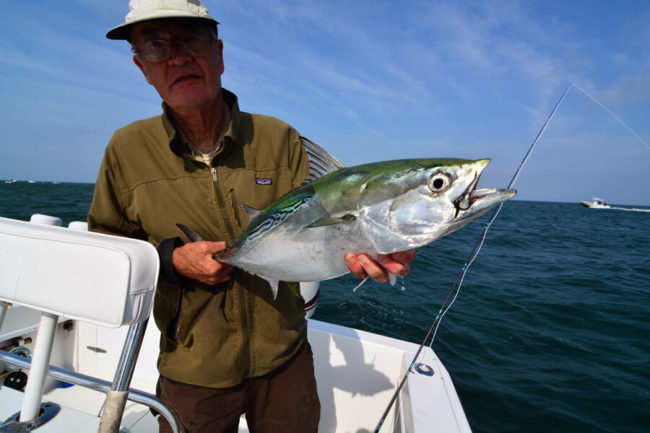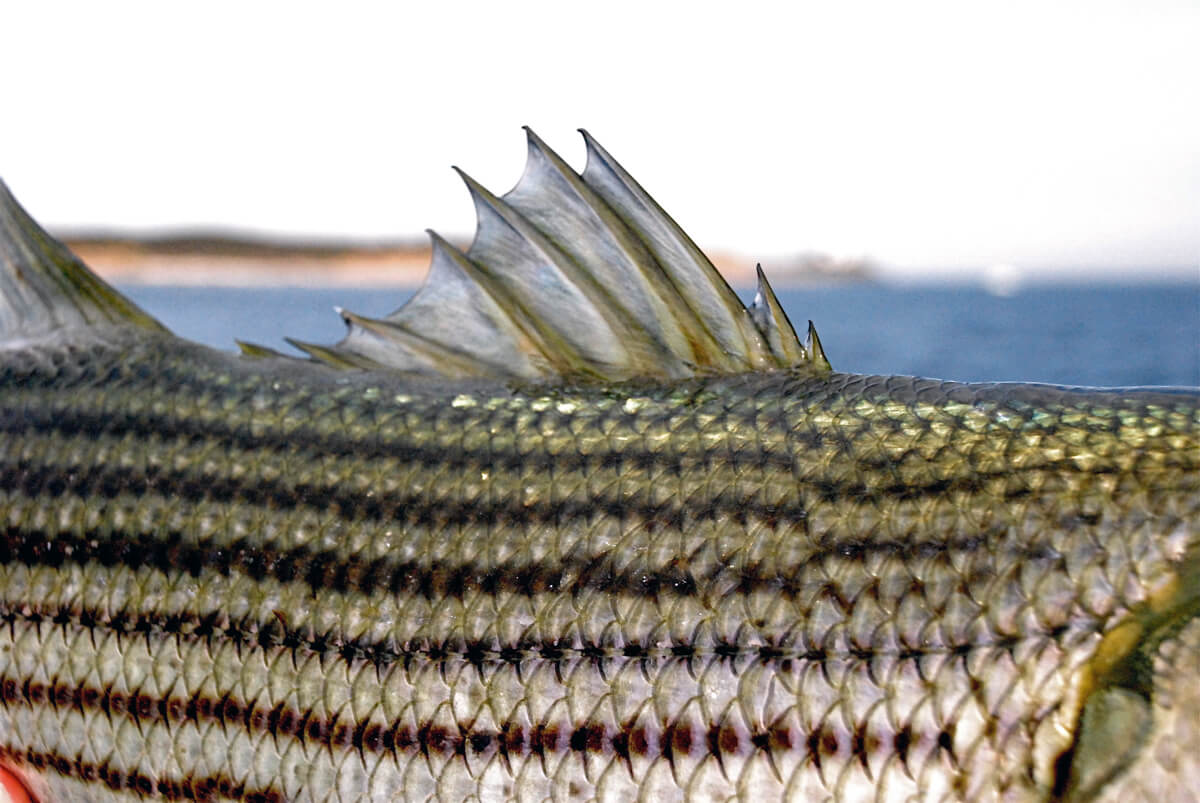Ted Williams writes about fish and wildlife issues for national publications. While he detests baseball, he’s even more obsessed with fishing than was the “real Ted Williams,” as he does not like to hear the ballplayer called.
Photos by David Blinken
The Scene
The greatest migrations on Earth do not occur on African savannas, Old World steppes, or North American flyways, but along the neck of the eastern funnel where Long Island juts into the North Atlantic. Here tide and wind clash over inshore and offshore bars, and sea creatures—most unseen save by anglers—stage, feed, and stream south and north.
In autumn, gannets fold their wings and pierce the waves as if shot by medieval archers. Peregrine falcons trade between south-side cliffs and north-side beaches. Ospreys and eagles hover and dive. Sea ducks swirl around the horizon like coal smoke.
Whales, dolphins, and seals graze on mile-long shoals of menhaden. Sea turtles—leatherbacks, loggerheads, and Kemp’s ridleys—cleave quieter water. Mola mola flop and wag.
Farther out, sharks, tunas, mahi, marlins, longfin albacore, king mackerel, and wahoo crash through schools of halfbeaks and frigate mackerel.
Starting in Indian summer, my friends and I are on hand to watch and participate. Bobbing in little boats, we jockey around rust-colored clouds of bay anchovies harried from above by screaming gulls and terns, harried from below by ravenous predator fish that send the inch-long bait spraying into the air like welding sparks.
The striped bass move slower and are packed tighter than the bluefish or false albacore. These “bass boils” can cover acres. They sound like washing machines, and they happen nowhere else.
My boat, a 21-foot green Contender, is named Assignment, so when my creditors and editors demand to speak to me, my wife can tell them, “He’s on Assignment.”
There’s only one occupation at which you can make less money than as a freelance nature writer, and that’s as a light-tackle fishing guide. It’s a calling I aspire to. The guiding I do now isn’t real. It’s philanthropy—pro-bono service for friends staffing and funding the Theodore Roosevelt Conservation Partnership, Trout Unlimited, and American Rivers.
The Fish
These days, virtually all the topwater bass are shorts, so I target only false albacore (aka albies), especially the big, raging pods. All that competition increases hookup chances exponentially.
Albies are mini tunas. They attain immense speeds via hard, sickle tails equipped with horizontal stabilizers, fins that fold into grooves and a ramjet-like oxygenating system whereby water is pushed, rather than pumped, through massive, blood-rich gills. The average 7-pounder will rip off 30 yards of backing before you can palm your reel.
Stripers and bluefish roll and splash. Albies erupt, flashing silver flanks. When they get excited they light up like billfish. Twice this past September I found them 100 feet off the Montauk Light, crisscrossing wildly around and under the Assignment, backs glowing neon green in the high sun. They were so beautiful I almost forgot to cast.
Fortunately, albies are the worst-eating fish in the sea. A commercial market does exist, however — in New York City’s Chinatown, where they’re sold as green bonito (among the best-eating fish in the sea). My friend Captain David Blinken, one of Long Island’s most popular and experienced light-tackle guides (northflats.com), was recently ejected from a Chinatown fish market for telling the owner a fact he didn’t want to know: that albies aren’t bonitos.
I can’t think that anyone eats albies. Forty years ago I broiled one, and it literally stank me out of the kitchen. My theory is this: Chinatown residents buy an albie because it’s beautiful. They take one bite, trash it, and never buy another. It’s just that there are so many Chinatown residents they maintain the market.
The threat to albies isn’t human consumption but a possible reduction fishery, perhaps for animal feed and similar to that which depleted menhaden. The false albacore’s tight schooling behavior and predictable migration routes make it vulnerable to industrial-scale purse-seining. Yet the National Marine Fisheries Service declines to regulate the species because it’s abundant. Such is the traditional mindset of fish managers: Don’t manage a stock until it’s depleted. And then manage it not for abundance but maximum sustainable yield: i.e., dead-on-the-dock poundage.

We don’t like to think of albies as baitfish, but that’s what they are. Blinken offers this: “False Albacore need to be protected now; we can’t afford to wait until it’s too late. They sustain marine ecosystems. Larger predators can’t make it just on forage like sand eels, anchovies, herring, and spearing. They need more protein. And albies give us guides a shot at diversity. Since the demise of the striped bass fishery we rely on them.”
From what I saw at Montauk in the fall of 2019, I wouldn’t say a striper demise has happened, but it sure seems to be on the way. It was nice to once again encounter massive bass boils extending from Shagwong Reef around the point and several miles along the south side. But not one bass I saw caught was over the 28-inch limit. Most get picked off as soon as they hit 28.
In 1984, after the states ran stripers into commercial extinction, Congress passed the Atlantic Striped Bass Conservation Act, a law requiring a moratorium on striper fishing in any East Coast state that refused to comply with a management plan hatched by the Atlantic States Marine Fisheries Commission (ASMFC).
Recreational anglers, then and now responsible for the vast majority of striped bass mortality, were limited to one fish daily at 36 inches. Stripers surged back.
But rather than managing for abundance, the ASMFC responded by expanding the recreational limit to two fish at 28 inches. The stock steadily dwindled, and it kept dwindling even after the ASMFC cut the limit to one fish at 28 inches. Finally, the ASMFC admitted what anglers knew: that stripers are “overfished.”
On October 30, 2019, the ASMFC had a chance to reverse the decline. Instead, it imposed a one-fish recreational slot limit for the ocean of between 28 and 34 inches.
“That decision dooms the 2015 and 2016 year classes,” remarks Blinken. “Why can’t we remember past lessons? Stripers are such special fish. You can find them in the rips or on the flats, 20 miles offshore or 20 miles up rivers. They fuel whole economies, providing income for hotels, restaurants, marinas and tackle shops. Now there are gillnetters all along the south side of Long Island. They’re blocking striper migration, creating boating hazards, killing turtles, birds, and marine mammals. And the six-pack guys [running large charters for recreational trollers] kill even more big breeders than the gillnetters. To destroy this resource to make a few people happy is so wrong.”
The Fishing
Albies can be as picky as brown trout, especially in fading light. When they get lockjaw, try a white Gartside Gurgler with lots of flash in the tail or a Crease Fly.
Blinken’s standby fly (which he originally invented for bonito) is the Jellyfish. “When I first started fishing albies I used only epoxy flies,” he says. “They’d bang off the hull or engine and shatter. So I started experimenting with a fly that was durable and could imitate lots of bait–squid, spearing, peanut bunker, anchovies. I’ve always tied my flies with feathers splayed. When I started doing Hi Ties I didn’t get enough movement, so I took some slender feathers and tied them into the back tarpon-style. Then I tied in uniform collars of synthetic material. When the fly sat it the water with the tendrils hanging down it looked like a jellyfish.”
Another popular Montauk fly is the Albie Whore, invented by our friend and Blinken’s regular client, Richard Reagan. It’s a bit like a Deceiver but tied with tail feathers splayed and side feathers anchored with hot glue. Google “Albie Whore” and you’ll get dozens of videos of guys tying it. Everyone save Reagan is tying it wrong (flylifemagazine.com/at-the-vise-albie-whore).
For albies, Blinken and I use only 10-weight fly rods. In deeper water, where most albies feed, a 10-weight has lifting power that 8-weights and 9-weights lack. “You want to beat that fish as quickly as possible so lactic acid doesn’t build up,” Blinken says. “Of course you can land an albie with an 8-weight, but you might kill it.”
Use an Albright knot to join leader to fly line. If a fly line comes with a loop, an Albright is all the easier to tie. A loop-to-loop connection creates a hinge effect that impedes your leader from turning over.
The angling mistake I see most is “trout striking”—i.e., lifting the fly rod instead of strip striking. Trout strikes guarantee missing at least half of your fish.
The next most common mistake I see is making too many false casts. For albies, Blinken and I use floating lines. They allow us to water haul and, with a single back cast, deliver the fly. “Albie fishing is very aggressive, very fast-paced,” says Blinken. “When the pod moves 20 feet to your left or right, you need to pick up and present it again quickly. If you’re using an intermediate or sinking line, you’re not going to get to those fish.”
When you’re throwing into big bait balls, matching the hatch is bad strategy. Why should a fish eat your fly when there are several hundred thousand baitfish that look just like it? Usually your flies should be two or three times bigger than the bait.
Guides make mistakes, too. Churlishness and too much advice are major turnoffs. And this from Blinken: “I think the biggest mistake a guide can make is having his client show up when it’s unfishable. We all want to make money, but if it’s blowing 25, you don’t tell your client to show up anyway, especially if it takes him four hours to get there. And guides need to be flexible. I keep my skiff available all fall, so if Montauk’s too rough, I can fish west.”
Once, when I was in Blinken’s boat, we watched a guide chase stripers in past the wave break. It’s a dangerous practice, but sometimes they can’t resist. “He’s gonna turtle,” yelled Blinken. When he did, we went in stern-first and fished out the client who had lost his rod, fly box, and car keys. Someone else fished out the guide, who didn’t get a tip that day. The boat rolled around under the cliffs all fall.
Best Conversation on the Water
I trailer the Assignment to Niantic, Connecticut, and cross to Long Island. After I tie up to the dock, I don’t like to hold up the scup guys. Scup are as prolific as they are delicious. The fishery has a huge African American following.
One early morning, after I’d parked my truck, I ran back to the ramp because nine scup anglers were preparing to launch a boat scarcely bigger than mine. They were headed a mile offshore, each with an excellent chance of filling his 30-fish limit.
One gentleman declared: “Take your time. You ain’t a young man no more.” Then he pointed to my one-piece Loomis rods and inquired what I was planning to do with the “long fish poles.” I explained that I was headed to Montauk to chase false albacore. Slapping his forehead, he intoned, “Twenty-five miles for fish you can’t eat?” (…continued)


